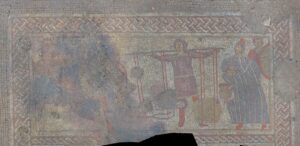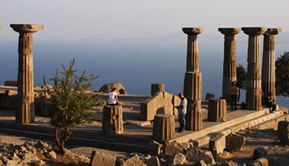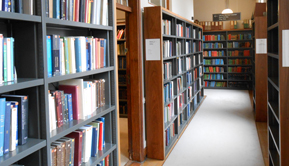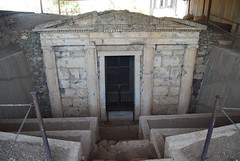No Mere Pavement
Jim Irvine, excavator of the mosaic, describes the thrilling moment he made the discovery of a lifetime
 The southern panel of the mosaic showing the dramatic weighing of Hector’s body against his weight in gold. Achilles is seated on the burnt left-hand side with two figures in attendance, while Priam places gold vessels onto the scales on the opposite side (© ULAS).
The southern panel of the mosaic showing the dramatic weighing of Hector’s body against his weight in gold. Achilles is seated on the burnt left-hand side with two figures in attendance, while Priam places gold vessels onto the scales on the opposite side (© ULAS).
Some time into lockdown during 2020, the grandparents were starting to get a little disgruntled at the lack of grandkid time they were getting. After several months of no contact, it was decided that we'd meet up in the field with a river running around its boundary so the kids could have a splash about. My wife, Freya, and our daughters headed out on a Saturday morning to meet up with my mum and dad (the grandparents) at the field.
As we were making our way down the slope to the river, there was a loud yell and my wife rolled onto the ground as if she was on fire. We quickly realised that we'd upset the bees in the nearby beehives, and they'd taken exception to our excitement and furor as we entered the field. A quick dash by all meant we avoided further stings and we eventually made it to the river.
The river was shallow and stony and the girls had a great time wading about and turning over rocks. We decided we shouldn't return past the bees, so we followed the river along the bare soil where the wheat had not grown due to flooding at the end of 2019. It was during this walk that I noticed some terracotta-coloured broken tiles, oyster shells and unusual black-coloured pottery. As we walked along, we started to notice that it was everywhere.
The finds came home with me, and that's when the research began. I'm an engineer so am naturally inquisitive and like to think I'm observant, but these finds didn't really align with my view of the location. There's a Victorian farm just across the river, but the pottery didn't look Victorian; it looked much older. Some investigation would be required.
I looked at old maps, Lidar and any aerial photographs I could lay my hands on. Eventually, by some serendipity, I happened to view an image from Google Earth that was taken in June 2018, during a particularly dry spell, when the wheat in the field was in the perfect growth phase to show clear field/crop marks. Visible on the image was the outline of a couple of adjoining buildings, one of which was slightly unusual in that it had turret-like features at each end. At this point, I was hooked, and just had to find out what this was. How could I not have noticed any evidence of this over 30 years of working for my dad on the farm? If I'm honest, I felt very excited, but slightly annoyed that I'd not previously picked up on the vast amounts of out-of-place debris strewn across the field.
If it wasn't for the bees, the flood and the drought, the last two years would have been far less exciting.
This was only the first part of the story. I drew up my findings and reported them to Helen Wells, who's our local Historic Environment Records officer. There was a suggestion of some 'Field Walking', but my impatience got the better of me, and I decided that as soon as the wheat had been harvested, I'd take my spade and make sure that the crop marks were actually identifying the location of this turreted building.
During August, the wheat was cut, and the field stood only as stubble. A Saturday morning was chosen, and me, the Irvine girls and my mum and dad arrived at the field, spade in hand. The sunshade was quickly thrown up and I located the spot where I thought I might find this 'wall'. I used the GPS on my phone, in conjunction with other location-identifying landmarks, trees in the hedge, tramlines made by the tractor, and the telegraph poles in the field to help me to locate myself.
I decided that a slot trench, about a spades-width, would suffice and allow me to prove myself right and expose the wall. After some digging, I came upon some unusual powdery material which was very loose at about 18 inches below the surface of the field. I cleared this out using the spade, and after a few more inches I hit something hard. Reaching down with my hand I cleaned out the powdery material, and exposed about a dozen 1-inch square tiles that were clearly the surface of a floor, or path. At this point I was a little surprised, and somewhat annoyed; I'd expected to find a wall, and instead I had found a path. I guess you can't be right all the time.
Some consternation ensued, and I decided that the next logical activity would be to dig some more, and find out what we'd discovered. At this point, I was working under the belief that I was excavating what must be the path that encircles the building that I'd seen in the crop mark. A few more spadefuls and, yet again, I was proven wrong; not a successful day in terms of making correct assumptions. What we did see, though, stunned us into silence. Adjoining the large tiles were a number of smaller tiles, bright in colour, and forming a pattern. This was clearly a mosaic of some sort, so with extreme care we continued to expose the pavement.
After an afternoon of careful work, we'd uncovered a large area and could clearly see figures, panels, borders and some excellent and delicate mosaic work. Not bad for our first go at archaeology.
Lots of photos were taken, and I filed my report on Monday with Helen Wells over the telephone. The call went something like this; "Hi Helen, it's Jim!". "Oh, hi Jim," replied Helen, probably wondering why I was calling again. "I'm going to send you a presentation, and I will talk you through it... but before I do, I need you to know that we were very VERY careful". "Oh-kay" said Helen. I sent over the report and described the day to her and talked her through all of the pictures I'd taken; she didn't say very much. At the end of the call, she said "Ummmm, I'm not really sure what's meant to happen now; let me call you back." I mentioned to my youngest daughter, Lyd, that Helen wasn't sure what would happen next, and Lyd responded, "Why? Is she new?"
Within a week, the whole circus arrived, and the professional archaeologists did a superb job of examining the mosaic, surveying the site and planning what would happen next.
Over the last couple of years, I've been privileged to be involved in some very special and unique archaeological work and have learnt an awful lot about Roman history, pottery, coins and buildings, as well as Greek mythology. It's been an absolute thrill.









